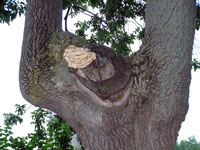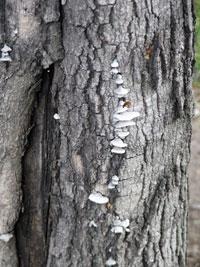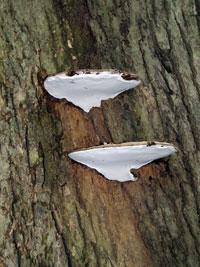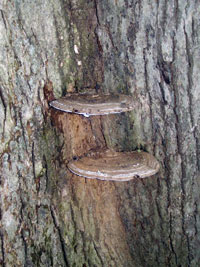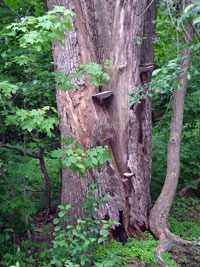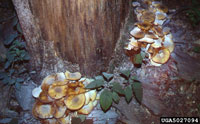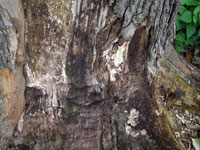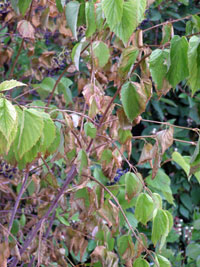Extension > Garden > Diagnose a problem > What's wrong with my plant? > Deciduous Trees > Maple > Fungi growing on trunks or branches
Maple > Trunk/Branches > Fungi growing on trunks or branches
1 of 4
Heart rot
Phellinus spp., Climacodon septentrionalis, Oxyporus
populinus and others
- Fungal fruiting bodies arise along the stem, near a pruning wound, crack or other wound
- The canopy may show no symptoms or may have small yellowing leaves or dead branches depending on the extent of the trunk decay
- In cross section of the trunk, the wood at the center is discolored, soft, crumbling, stringy or spongy
- Many shapes and sizes of fungal fruiting bodies may be seen
- More information on heart rot
2 of 4
Sapwood rot
Schizophyllum commune and Cerrena unicolor
- Schizophyllum shelf fungi are white and appear fuzzy on top
- Cerrena shelf fungi are white to greenish grey and have concentric rings on the surface
- Dead branches within the canopy
- Groups or rows of small (<2 inches wide) semi-circle self fungi along killed branches or on the main trunk
- Occurs on trees with an open wound or crack
- Wood below fungal shelves is yellowish to white, crumbly and decayed; bark around fungal shelves is killed and often falls off
3 of 4
Ganoderma root and butt rot
Ganoderma spp.
- Conks are reddish brown and shiny on top, white and porous underneath, a rim of white may be visible on the edge of growing conks
- Leaves are smaller in size and turn yellow earlier than normal
- Canopy appears thin with few leaves and multiple dead branches
- Fungal conks, a semicircle shelf fungi, can be found from the base of the tree up to 3 feet high on the trunk
- Infected wood at the base of the tree is white, soft, stringy or spongy
- Infected trees frequently break or fall over in storms
- More information on Ganoderma root and butt rot
4 of 4
Armillaria root rot
Armillaria spp.
- Clusters of honey-colored mushrooms may grow at the base of the tree in fall
- Flat white sheets of fungal growth (mycelia fans) grow between the bark and sapwood at the base of infected trees
- Thick black, shoestring-like fungus can sometimes be seen under the bark, around roots and in the soil around the base of the tree
- Wood is decayed, white, soft and spongy, and this may extend from the base of the tree well up into the trunk.
- Trees frequently break or fall over in storms
- More information on Armillaria root rot




